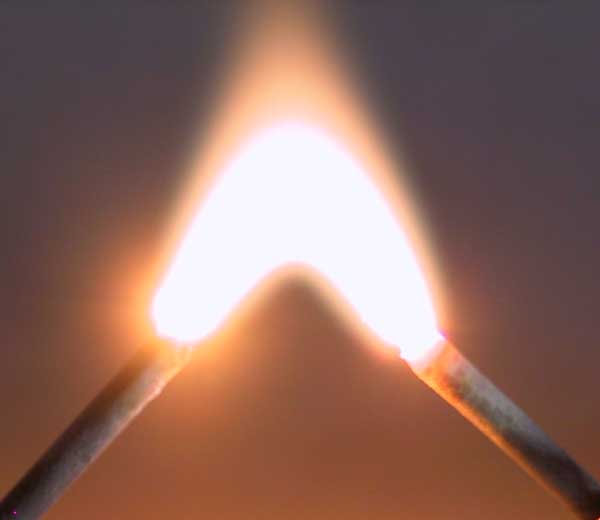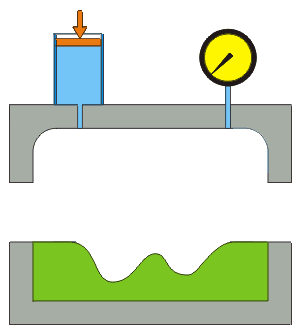|
Electrohydraulic Forming
Electrohydraulic forming is a type of :Metal forming, metal forming process in which an electric arc discharge in liquid is used to convert electrical energy to mechanical energy and change the shape of the workpiece. A capacitor bank delivers a pulse of high current across two electrodes, which are positioned a short distance apart while submerged in a fluid (water or oil). The electric arc discharge rapidly vaporizes the surrounding fluid, creating a shock wave. The workpiece, which is kept in contact with the fluid, is deformed into an evacuated die (manufacturing), die. The potential forming capabilities of submerged arc discharge processes were recognized as early as the mid-1940s (Yutkin L.A.). During the 1950s and early 1960s, the basic process was developed into production systems. This work principally was by and for the aerospace industries. By 1970, forming machines based on submerged arc discharge were available from machine tool builders. A few of the larger aerospace ... [...More Info...] [...Related Items...] OR: [Wikipedia] [Google] [Baidu] |
Electric Arc Discharge
An electric arc (or arc discharge) is an electrical breakdown of a gas that produces a prolonged electrical discharge. The current through a normally nonconductive medium such as air produces a plasma, which may produce visible light. An arc discharge is initiated either by thermionic emission or by field emission. After initiation, the arc relies on thermionic emission of electrons from the electrodes supporting the arc. An arc discharge is characterized by a lower voltage than a glow discharge. An archaic term is voltaic arc, as used in the phrase "voltaic arc lamp". Techniques for arc suppression can be used to reduce the duration or likelihood of arc formation. In the late 19th century, electric arc lighting was in wide use for public lighting. Some low-pressure electric arcs are used in many applications. For example, fluorescent tubes, mercury, sodium, and metal-halide lamps are used for lighting; xenon arc lamps have been used for movie projectors. Electric arcs ... [...More Info...] [...Related Items...] OR: [Wikipedia] [Google] [Baidu] |
Electrical Energy
Electrical energy is the energy transferred as electric charges move between points with different electric potential, that is, as they move across a voltage, potential difference. As electric potential is lost or gained, work is done changing the energy of some system. The amount of work in Joule, joules is given by the product of the charge that has moved, in Coulomb, coulombs, and the potential difference that has been crossed, in Volt, volts. Electrical energy is usually sold by the kilowatt hour (1 kW·h = 3.6 MJ) which is the product of the power in kilowatts multiplied by running time in hours. Electric utilities measure energy using an electricity meter, which keeps a running total of the electrical energy delivered to a customer. Electric heating is an example of converting electrical energy into thermal energy. The simplest and most common type of electric heater uses electrical resistance to convert the energy. There are other ways to use electrical energy. Electri ... [...More Info...] [...Related Items...] OR: [Wikipedia] [Google] [Baidu] |
Mechanical Energy
In physical sciences, mechanical energy is the sum of macroscopic potential and kinetic energies. The principle of conservation of mechanical energy states that if an isolated system is subject only to conservative forces, then the mechanical energy is constant. If an object moves in the opposite direction of a conservative net force, the potential energy will increase; and if the speed (not the velocity) of the object changes, the kinetic energy of the object also changes. In all real systems, however, nonconservative forces, such as frictional forces, will be present, but if they are of negligible magnitude, the mechanical energy changes little and its conservation is a useful approximation. In elastic collisions, the kinetic energy is conserved, but in inelastic collisions some mechanical energy may be converted into thermal energy. The equivalence between lost mechanical energy and an increase in temperature was discovered by James Prescott Joule. Many devices are us ... [...More Info...] [...Related Items...] OR: [Wikipedia] [Google] [Baidu] |
Die (manufacturing)
A die is a specialized machine tool used in manufacturing industries to cut and/or Forming (metalworking), form material to a desired shape or profile. ''Stamping (metalworking), Stamping dies'' are used with a machine press, press, as opposed to ''Draw plate, drawing dies'' (used in the manufacture of wire) and ''Die casting, casting dies'' (used in Molding (process), molding) which are not. Like molds, dies are generally customized to the item they are used to create. Products made with dies range from simple paper clips to complex pieces used in advanced technology. Continuous production, Continuous-feed laser cutting may displace the analogous die-based process in the automotive industry, among others. Die stamping Blanking and piercing are two Shearing (manufacturing), die cutting operations, and Bending (metalworking), bending is an example of a die forming operation. Die forming Forming operations work by deforming materials like sheet metal or plastic using force (Compre ... [...More Info...] [...Related Items...] OR: [Wikipedia] [Google] [Baidu] |
Ignitron
An ignitron is a type of gas-filled tube used as a controlled rectifier and dating from the 1930s. Invented by Joseph Slepian while employed by Westinghouse Electric Corporation, Westinghouse, Westinghouse was the original manufacturer and owned trademark rights to the name "Ignitron". Ignitrons are closely related to mercury-arc valves but differ in the way the arc is ignited. They function similarly to thyratrons; a triggering pulse to the igniter electrode turns the device "on", allowing a high current to flow between the cathode and anode electrodes. After it is turned on, the current through the anode must be reduced to zero to restore the device to its nonconducting state. They are used to switch high currents in heavy industrial applications. Construction and operation An ignitron is usually a large steel container with a pool of mercury (element), mercury in the bottom that acts as a cathode during operation. A large graphite or refractory metals, refractory metal cylind ... [...More Info...] [...Related Items...] OR: [Wikipedia] [Google] [Baidu] |
Hydroforming
Hydroforming is a means of shaping ductile metals such as aluminium, brass, low alloy steel, and stainless steel into lightweight, structurally stiff and strong pieces. One of the largest applications of cost-effective hydroforming is the automotive industry, which makes use of the complex shapes made possible by hydroforming to produce stronger, lighter, and more rigid unibody structures for vehicles. This technique is particularly popular with the high-end sports car industry and is also frequently employed in the shaping of aluminium tubes for bicycle frames. Hydroforming is a specialized type of die forming that uses a high pressure hydraulic fluid to press room temperature working material into a die. To hydroform aluminium into a vehicle's frame rail, a hollow tube of aluminium is placed inside a negative mold that has the shape of the desired result. High pressure hydraulic pumps then inject fluid at very high pressure inside the aluminium tube which causes it to expand ... [...More Info...] [...Related Items...] OR: [Wikipedia] [Google] [Baidu] |


